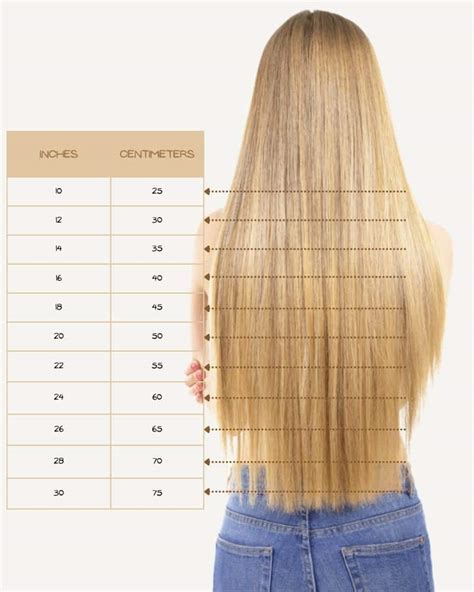Knowing the length of your hair is crucial for maintaining a healthy and stylish look. This inch chart will provide you with a comprehensive overview of hair length, helping you determine your current hair size and plan for future growth.

Understanding Hair Measurement
Hair length is typically measured from the scalp to the tip of the hair shaft. The most common unit of measurement is inches, with each inch representing approximately 2.54 centimeters. To accurately measure hair length, hold a ruler or measuring tape vertically at the base of the scalp and extend it to the end of the hair.
Hair Length Chart
| Length (Inches) | Description |
|---|---|
| 0.25-0.5 | Pixie cut |
| 0.5-1 | Short bob |
| 1-2 | Long bob (lob) |
| 2-4 | Shoulder-length |
| 4-6 | Medium-length |
| 6-8 | Long-length |
| 8-10 | Extra-long |
| 10-14 | Waist-length |
| 14-18 | Hip-length |
| 20+ | Classic length |
Average Hair Growth Rate
On average, hair grows approximately 0.5-0.6 inches per month. However, hair growth rates can vary significantly depending on factors such as age, genetics, diet, and health conditions.
Factors Affecting Hair Growth
- Age: Hair growth tends to slow down with age.
- Genetics: Genes play a major role in determining hair growth rate and length.
- Diet: A healthy diet rich in vitamins, minerals, and protein supports hair growth.
- Hormones: Hormones such as estrogen and testosterone can influence hair length.
- Hair care practices: Excessive heat styling, harsh chemicals, and poor scalp hygiene can damage hair and inhibit growth.
- Medical conditions: Certain medical conditions, such as alopecia, can lead to hair loss and affect growth.
How to Measure Hair Growth Over Time
To track hair growth progress, you can use the following methods:
- Monthly ruler measurements: Measure hair length at the same spot on the scalp each month.
- Photographs: Take photos of your hair from the same angle and lighting conditions every few months to observe changes in length.
- Hair growth tracker apps: Utilize mobile apps that allow you to log hair measurements and monitor growth.
Strategies for Promoting Hair Growth
- Maintain a healthy diet: Consume plenty of fruits, vegetables, and lean protein.
- Exercise regularly: Physical activity promotes blood flow to the scalp and nourishes hair follicles.
- Reduce stress: Stress can trigger hair loss.
- Use volumizing products: Certain shampoos and conditioners can create the illusion of fuller, longer hair.
- Consider hair extensions: Hair extensions can temporarily add length and volume to your hair.
The “Hair-razing” Concept
Embracing short hairstyles can be empowering and liberating. By experimenting with different lengths, you can discover your unique style and enjoy a fresh perspective on your appearance.
Conclusion
This hair inch chart provides a valuable resource for understanding hair length and monitoring growth over time. By considering the factors that influence hair growth and adopting effective strategies to promote healthy hair, you can achieve the length and style you desire. Whether you embrace short hair or strive for long, flowing locks, this comprehensive guide will empower you to make informed decisions about your hair care journey.
